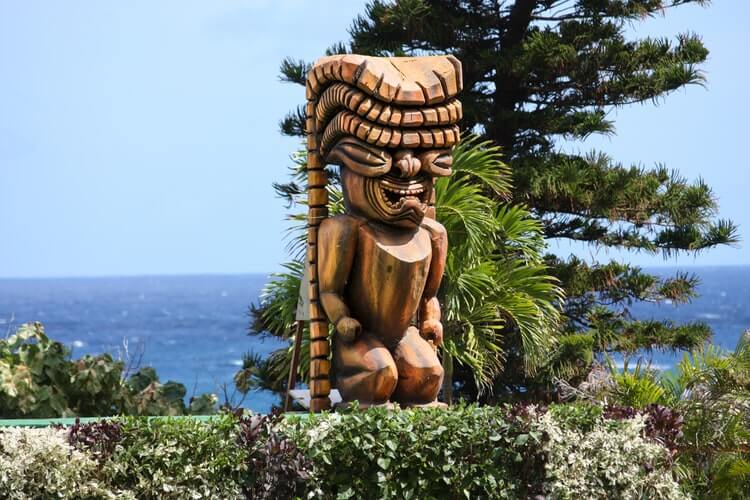Native Hawaii, both before and after European contact, presents a rich and diverse culture. This inspires Hawaiian artists to express their creativity through multiple forms of art.
Variations of Hawaiian art include feather work, kapa (bark cloth), sculpture, painting, photography and tattoo art. Some Hawaiian art forms are not just decorative but bear practical and spiritual purposes too.
Hawaiian sculpture or ‘Tiki’ is one such art form.
Tiki art is inspired by the ancient Polynesian culture where people believed in Tiki gods. Ancient Hawaiians made sculptures of these deities mainly for worship and spiritual guidance.
Since then Tiki sculpture has become an inherent part of Hawaii. In this blog post, we will explore the background of Hawaiian sculpture and where you can find Tiki art in Kauai.
History of Hawaiian Sculpture or Tiki
Tiki are also called Ki’i in Hawaiian. The word ‘Tiki’ originates from New Zealand’s Maori tradition. Tikis can be traced back to ancient Polynesian culture, which explains their influence on the Hawaiian mainland.
According to Maori customs and traditions, Tiki represents the first human being on earth. Parallelly, tiki also refers to stone or wooden carvings in humanoid form.
Before missionaries, the Polynesian culture largely influenced ancient Hawaii. Ancient Hawaiians worshipped four main Tiki gods- Kane, Ku, Kono and Kanaloa- and several Demi-gods. Kane represented the god of creation, sunlight, forests and freshwater. Likewise, Lono was the god of agriculture and peace, Kanaloa represented the god of the sea realm, and Ku, the god of war.
Hawaiian tiki sculptures were made to represent these gods and the embodiment of their specific powers. It is said that the expressions on the Tiki or Ki’i mirrored the personalities of respective gods. This is why some statues wear expressions of joy and calm, while others look troubled and ferocious. Symbolism played an essential role back then.
Hawaiians saw these gods as their protectors. So tiki statues were used to mark the boundaries of sacred and significant sites like heiaus. Every action in the ancient Hawaiian society revolved around appeasing and paying homage to these gods. This was done through prayer, chanting, lava sledding, and even human sacrifice.
Not everyone had the right to carve Tiki statues. The statues carved by high-ranking tribesmen, were considered sacred and powerful to be used in religious ceremonies. Those carved by the rest merely served decorative purposes.
In 1819, King Kamehameha II abolished the ancient system of religion and had a majority of temples and tikis statues destroyed. Shortly after that, European missionaries arrived in Kauai and the tiki influence began to fade away.
Fortunately, Tiki-pop culture rose to popularity in the 1930s. It all started when navigators in search of new lands discovered exotic tropical islands and the Polynesian culture. When these sailors went back with souvenirs, they shared stories about the people and culture they experienced. This began society’s fascination with the strange-looking gods and their statues, which, ever since, has been growing.
Small, quaint bars embraced Polynesian culture and rode the tiki wave. These bars not only used Polynesian elements to decorate their interiors, but also specialized in making rum based cocktails, called ‘Tiki’. That’s how these bars came to be called tiki bars. You can find several such tiki bars in Kauai today.
Where to find Hawaiian sculpture or Tiki in Kauai
Very few ancient tiki statues remain on the island today. But talented Hawaiian sculptors and artists have kept the culture alive through impressive forms of art. From big carvings displayed at open places to tiny artifacts sold at local flea markets, there are several places to find the tiki.
Here are a few of them:
Havaiki Oceanic and Tribal Art, Hanalei
Tiki poles and flaming torches are what you’ll first see before entering this place. Part gallery and part gift shop, Havaiki Oceanic and Tribal Art features a carefully curated collection of Hawaii’s primitive treasures. Each displayed item has a story that is rooted in Polynesian traditions practised in Hawaii. The gift shop has an impressive collection of tiki carvings and art to select from.
Kaneioluma Complex, Poipu
Kaneiolouma complex is a cultural site that contains remnants of an ancient Hawaiian village and Heiaus dating back to a millenia. Located in the heart of Poipu, four 16 foot tall Ki’i or Tiki carvings are erected on the revered site. These statues were carved by James Kanani Kaulukukui Jr. of Big island. In addition to tiki statues, the 13-acre complex contains hale sites, fishponds, taro fields, auwai irrigation systems, and a makahiki arena dating back to the 1400s.
Tiki Iniki, Princeville
This exotic bar specializes in tiki cocktails and island cuisine. The cocktails are heavenly and the vintage tiki-inspired ambiance is mind-blowing. The tonga drum lightings, carved tiki poles, mugs, and art provide the escapism you need as you’ll be transported back to the ancient tiki era.
Final Thoughts on Hawaiian Tiki Art
Besides these places, you can find tiki art in hotels and resorts, luau celebrations, and museums. Sometimes at random places too. The Hawaiian people are said to have descended from the lineage of gods. Modern-day Hawaiian sculptors and artists are doing their best to preserve this legacy in memory of a time when peoples’ lives were closely intertwined with their gods.
Experience the stunning Napali Coast in the most enjoyable way. Book your Napali coast boat tours today!



Comments
Opening all year around, hours , dates? Taking my lovely family on vacation, I would love to share this great eye site of memories to him… please send brochures to 904 s. 16th st. Fort Didge Iowa 50501